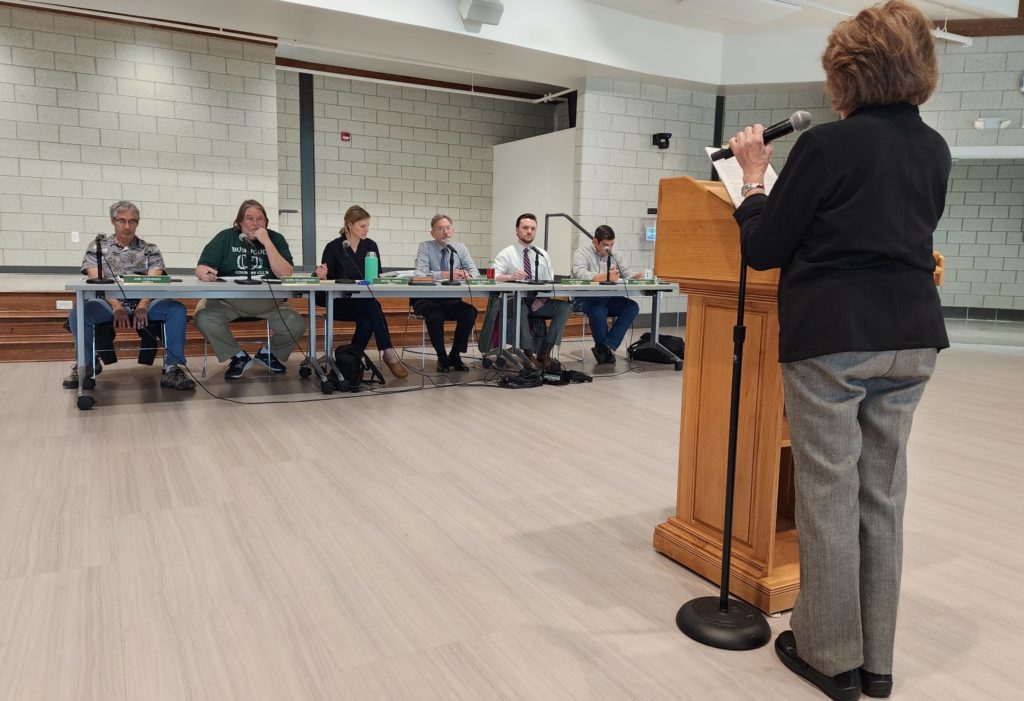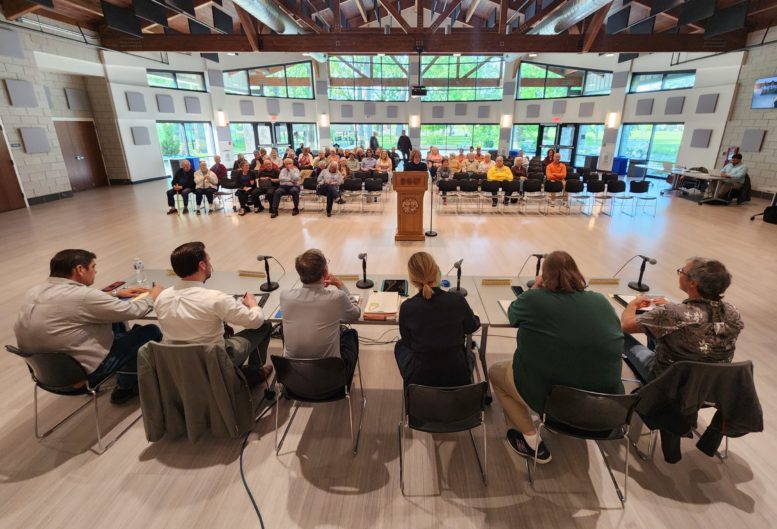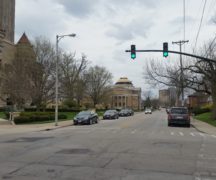By JAN LARSON McLAUGHLIN
BG Independent News
Residents of the older blocks surrounding downtown Bowling Green, asked City Council Wednesday to protect their historic neighborhoods and not sell them out to landlords.
“You have a jewel in this community,” said David Neuendorff, who recently moved to Bowling Green from Toledo. “You need to protect the historic nature of Bowling Green.”
That means the city must stop landlords from chopping up older homes, he said to City Council during the public hearing on the zoning code ordinance. Most of those present spoke in opposition to the Pedestrian Residential zoning provisions that would allow duplexes in the residential blocks.
“You have a jewel,” Neuendorff repeated. “Is it for sale? Or are you going to preserve it?”
Karen Wood, who lives on the East Side of the city, voiced her fear that neighborhoods along streets like Buttonwood and Maple will be changed – and not for the good.
“I fear that the west side of Bowling Green will begin to look like the east side of Bowling Green,” Wood said.
She suggested that the city hire an ombudsman to take care of issues that arise with the zoning changes, and that the city puts some teeth in its zoning laws.

Jan Knape shared similar concerns, after presenting council members with slides of poorly maintained rental properties in her neighborhood. Knape asked that duplexes and backyard “additional dwelling units” not be allowed in the neighborhoods deemed pedestrian residential.
“We want to keep single-family homes as single-family homes,” she said. “Please protect our historic homes and our property values.”
David Pfleger said the city already has at least 260 non-conforming properties that were grandfathered in when zoning was adopted. He referred to studies completed for the city that cited the need to stop the compartmentalization of houses, and address the issues of deferred maintenance and blight.
Neuendorff ridiculed the use of “self-inspections” by landlords to guarantee safe rental housing. “The zoning code is not enforced,” he said, noting that a quick drive down alleyways will show the state of several rental properties. “We don’t inspect in Bowling Green.”
At the least, the city should require fire inspections of all rental housing by the fire division, he said.
Joe DeMare accused City Council of being swayed by the “outsized influence” of landlords in the community. The voluntary inspection system is proof, he said, adding that council “bowed to the wishes of the landlords.”
DeMare asked City Council to not listen to wealthy landlords, who will benefit from greater density. “We need you,” he said, asking council to listen to homeowners who live in the older neighborhoods.
Kathleen Dixon was also critical of the self-inspection system.
“It’s ludicrous,” she said. “It’s a failure of our responsibilities to renters.”

Steve Ricard asked that the city get its housing code enforcement in order before adding any more potential problems. He talked about the nuisances created by many short term rental properties. And he asked that Additional Dwelling Units in backyards be banned in pedestrian residential zoned areas.
ADUs are promoted as ways to add value to properties and inexpensive ways to add more housing options. But Ricard predicted problems.
“They won’t be used by your granny, or my granny, or your in-laws,” he said. “In Bowling Green, ADUs will be built as rentals.”
But Matt Bostdorff, who owns rental properties, defended the duplex concept. While noting that the majority of the audience was “glaring at me from behind,” Bostdorff said that the more money made by landlords, the more tax revenues go to the city.
“I am a proponent of the zoning change,” he said, expressing concern that the ordinance may end up watered down “because we’re so hyper-focused on one small piece of the code.” He said fear is being used to keep the city from making positive changes.
The duplex option would allow homeowners to reinvest in their neighborhoods and add on for family growth, he said.
“Don’t underestimate the need for rentals as affordable housing,” Bostdorff said.
Matt Kaufman also spoke in favor of the zoning ordinance. Bowling Green has very little to offer in terms of housing for young professionals, he said, referring to people who wanted to stay in Bowling Green, but couldn’t find suitable, affordable housing.
With homeownership becoming out of reach for many young people, rental housing that isn’t marketed for college students is in great demand, Kaufman said.
“Our generation is kind of being boxed out,” he said. “I’ve known people who lived in BG and wanted to live here long-term, but they moved out.”
Kaufman spoke in favor of more duplexes and ADUs. “The need is higher than ever,” he said.
But Ross Mazzapappa, a young professional, voiced his opposition to two-unit housing. He recently bought a home in the pedestrian residential area, where so many multi-unit homes already exist.
“This is the oldest and most affordable housing in the city,” he said. “I implore you to protect these neighborhoods.”
Housing accessibility isn’t an issue – but code enforcement is, Mazzapappa said.

Rose Hess urged council to enforce the court ruling that allows as many unrelated residents in a home as there are bedrooms.
David Drain referred to a petition signed by more than 600 people opposed to the increased density in the older neighborhoods. He also talked about the survey conducted by members of the BG Save Our Neighborhoods Group that showed less than 60% of the dwelling units in the area are single family homes. At least 40% are already two-unit, multi-unit dwellings or ADUs, Drain said.
“This is much greater density than other areas of the city,” he said. “Parking is a terrible problem in our neighborhoods.” He suggested that other areas of the city could better handle the additional density.
Sandy Wicks noted the number of people who felt compelled to sign the petition – more than 600. That kind of public input hasn’t been seen in at least the last 30 years, she said. “It is very significant.”
Council member Jeff Dennis noted that city officials had never been given the petitions. Drain said he would send them to council members.
Wicks asked that council postpone any vote on the ordinance, and that a committee be formed of homeowners, businesses, renters and city officials, to study the zoning changes.
Rose Drain asked that design standards be added to the pedestrian residential zoning. Among the components would be historic preservation, required parking places, new construction similar to existing styles, no external staircases or balconies, and canopy tree requirements.
“To preserve and protect a valuable asset of the city of Bowling Green, the central residential neighborhoods, there need to be design standards,” Rose Drain said. “Construction in these neighborhoods needs to respect what is already here and fit well with existing homes.”
At the end of the meeting, council members thanked the public for their persistence. Council President Mark Hollenbaugh asked council members to submit their proposed amendments to the zoning ordinance prior to the next meeting on June 12. At that meeting, City Council will vote on any amendments and on the ordinance.





